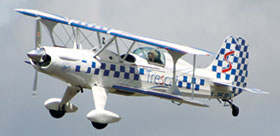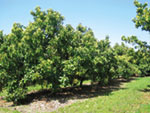

There is a family-run DIY shop in Winchester: it does not have the attractive displays of the DIY supercentres, it is crammed with stuff in crowded aisles, and you have to ask where to look for anything. But then the staff know exactly where it is, are knowledgeable about how to use it, and make a good guess as to why you want it, and suggest two other things that might also be useful. So you come out with more than you wanted, but with reassurance. More important, they made the sale, helped the customer, and sold a few more bits. You have to admire their sales expertise, and their business just keeps on growing.
Calibration group turns an aerobatic hobby into an advertising opportunity
Occasionally you recognise similar marketing initiative in industry. In the public display days at the Farnborough Air Show this year there are aircraft enthusiasts (like me) lined up along the barriers, all probably with jobs that impinge on aviation, or engineering, or similar. So while waiting all day for his 10 minute display slot, Jean-Marc d’Hulst, the pilot of a French Starduster SA300 aerobatic biplane, walked along the crowd line handing out postcards showing his aircraft, chatting to anyone interested, and listened to by everyone around.
Turning the postcard over you realise that it is advertising the Trescal Group – which explains the name painted on the side of the aeroplane. This group is a worldwide network of companies that provide calibration, repair and verification services, special-ising in the requirements of the avionics industry. These days, with traceability and accountability paramount, such services are in high demand, not just from the aerospace industry, and are usually bought in from a third party, so the records can be seen as from independent inspectors, and the third-party supplier takes on all the hassle of maintaining the traceability for their test equipment.

Jean-Marc d’Hulst is a VP of Trescal: the company news on its website shows they seem to acquire another laboratory in another country every few months. They now have 180 laboratories in 21 countries: these labs cover Europe, Asia, USA, South America and North Africa, at the moment. Trescal also provide engineering training and consultancy on measurement problems to improve process performance for all types of industry. Jean-Marc has displayed this year at the Paris, Farnborough, Berlin and Marrakech air shows, and indeed his company expertise was also broadcast during the public commentary at each display. With these marketing skills also applied to the group acquisition and expansion strategy, maybe Jean-Marc will bring his Starduster display to South Africa shortly!
Spirent Communications solves an irrigation problem using IoT concepts
When you are a marketing and applications engineer, like Kurt Bantle, and work for a major electronics company like Spirent Communications, it is a good idea to buy a house in California out in the sticks with a back garden that anyone else would call a big paddock. But once this is filled with 900 young avocado trees, it can come as a shock when the bill for the water needed to keep these trees alive comes to $47 000, each year. This arises from the current drought conditions in Southern California, where draconian restrictions have been placed on the water supplies, and it is affecting all the avocado groves – and maybe 95% of US avocado production is in this area. Farmers in many parts of the world face such problems.
When he was tasked with developing markets for the Spirent IoT offering, there was an opportunity to combine work with his gardening problems. Watering the trees is needed to feed the roots, which are in the top layers of the soil, and also to wash the salts down past the root zone, which reduces stress on the trees and enables better crop production. So a soil moisture meter in the top layer, and another at around 2 feet underground, can switch on the irrigation when the root needs it, and switch it off when the lower sensor sees the moisture and salts arriving.
Bantle divided his olive trees into 22 irrigation areas, each containing 40 trees, two moisture sensors, a water supply valve and valve controller. Using a LoRaWAN low power wide area network (www.lora-alliance.org), each irrigation block sends status data to a LoRa Gateway, which has a connection via a broadband cellular uplink to the cloud. Here the data is stored, and instructions to turn on the irrigation sent back down when needed, using a reprogrammable SIM from Oasis, a partner company with Spirent.
The total equipment cost him $8 200, or would have, if he had not offered the scheme as an example for marketing use by Spirent, of course. This was recouped by the water savings in the first six months. His annual water bill was cut by 75%, to just under $12 000. Spirent see this as a major method of reducing irrigation costs for any vegetable or fruit farm, including almonds, olives, apples, oranges and tomatoes, and are promoting the application story.
As for Kurt Bantle, his sudden drop in water consumption caused an investigation by the water company, who thought he was tampering with their water meter! Hopefully, he is not still under such suspicion and able to promote the application for Spirent.

Nick Denbow spent thirty years as a UK-based process instrumentation marketing manager, and then changed sides – becoming a freelance editor and starting Processingtalk.com. Avoiding retirement, he published the INSIDER automation newsletter for 5 years, and then acted as their European correspondent. He is now a freelance Automation and Control reporter and newsletter publisher, with a blog on www.nickdenbow.com

© Technews Publishing (Pty) Ltd | All Rights Reserved